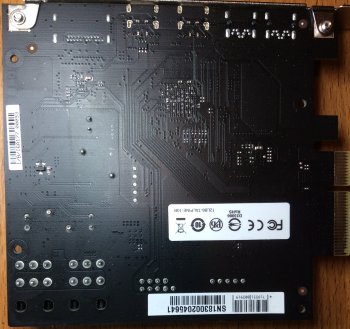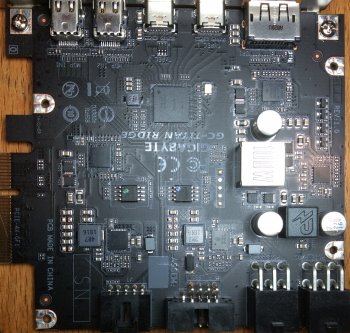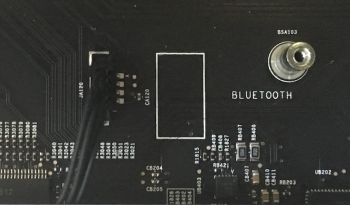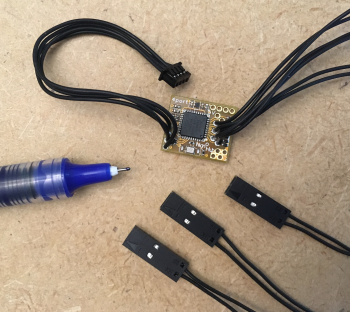Has the card been arrived? What are the experiences?Still waiting for the delivery. It is shipped, but it will take another few weeks to arrive!
Thanks!
Has the card been arrived? What are the experiences?Still waiting for the delivery. It is shipped, but it will take another few weeks to arrive!
I didn't use a probe to check. I don't think the +5V pins are connected to anything. The backside shows the traces for D- and D+. The Ground pins may be connected to the backside ground plane.I'm curious about something. Would anybody be willing to take a look at the PCB of the Titan Ridge card and tell me if there are any traces attached to the pins indicated in the pictures below?


Shouldn't USB hubs be powered by 5V?@joevt thanks so much for the information! So it seems that connecting just D+/- should be enough. Although I don't yet have a Titan Ridge card, I've already put together a tiny hub solution for the bluetooth header. Since the hub is powered by the 3.3V that the header provides, it is only suitable for the data lines.
Right. D- and D+ only need 2.8–3.6 V.Good question. My hub uses a controller that works on 3.3V. Although the hub expects to regulate 5V to 3.3V for the controller, powering it by the 3.32V (measured) of the bluetooth header results in something still over 3V, a level at which the controller remains fully functional. I've tested the hub with various storage devices (powered externally) and the bluetooth module of my WiFi card (data lines only), and I expect that it will work with the Titan Ridge card.
Good question. My hub uses a controller that works on 3.3V. Although the hub expects to regulate 5V to 3.3V for the controller, powering it by the 3.32V (measured) of the bluetooth header results in something still over 3V, a level at which the controller remains fully functional. I've tested the hub with various storage devices (powered externally) and the bluetooth module of my WiFi card (data lines only), and I expect that it will work with the Titan Ridge card.
For now, I'm just going to run a single USB2 from the bluetooth header to the card using just D+/D-. I've got a spare bluetooth 4 pin cable that I can chop up.
You need two USB 2.0 ports - on for each Thunderbolt port. So maybe you should use a hub if you don't want to take away two ports from the Mac Pro. The hub should be powered so the ports of the hub have the same power as from the Mac Pro. The hub should be USB 2.0 because 3.0 would be a waste..
Any Mac compatible USB port should work. Woof Woof's tests with the Bluetooth USB data lines will tell us if power is required (probably not, in which case I will take back my statement that a hub should be powered - extra power is still useful for ports that will not be connected to the Titan Ridge).Can't a compatible USB 3.0 PCI with internal USB ports work? Take the Inateck KTU3FR-5O2U for example which has 2 internal PCI 3.0 ports. Isn't USB 3.0 backwards compatible with USB 2.0 anyways?
A USB mouse with a USB-C to USB-A adapter is sufficient. You should see the mouse connect to a USB 2.0 port in IORegistryExplorer.app or ioreg or System Information.app.I'm going to have to test USB2 some other way. I have a thunderbolt to USB A adapter... and I *think* it is a passive adapter, but I don't know for sure yet.
Some devices give me problems where I can't warm boot into Windows, but warm booting into macOS works.I did get an Apple thunderbolt ethernet adapter working in Mojave after a restart from Windows. (Titan Ridge -> Apple TB3 to TB2 adapter -> Apple Thunderbolt Ethernet adapter) It pulled an IP address, so it was working. One thing of note, Windows refused to boot with the ethernet adapter plugged in, but allows me to hot plug it.
This problem goes away if you connect both DisplayPort inputs of the GC-TITAN RIDGEI did briefly test display port passthrough in Windows. I connected GPU to Titan Ridge to TB3 multi-adapter to HDMI Display. Odd thing was, I had to have the displayport bridge cable connected in the lower mini-displayport jack and the multi-adapter in the higher TB3 port (Port 1). It also took a fair bit of time to light up.
Now we just buy everything online and wait a few days for delivery.Ohh for the days I could just walk into Radio Shack to get more heat shrink tubing.
I received my Titan Ridge card. I can confirm that the data lines are enough for USB 2. I tested this with one of the ports on the back of the machine. However, I can't seem to get it working with my bluetooth header hub. I wonder if it has to do with noise on the lines, because I'm using unshielded wire...
Just trying to eliminate the HUB as the issue.
A USB mouse with a USB-C to USB-A adapter is sufficient. You should see the mouse connect to a USB 2.0 port in IORegistryExplorer.app or ioreg or System Information.app.
Some devices give me problems where I can't warm boot into Windows, but warm booting into macOS works.
This problem goes away if you connect both DisplayPort inputs of the GC-TITAN RIDGE
Now we just buy everything online and wait a few days for delivery.
No, only the USB 3.1 gen 2 controller works from cold-boot.Haven't checked here in ages. Has anyone got one of these cards working without a warm-boot?
The single 2 pin connector is from the bluetooth. The heatshrink contains the hub. The two 2 pin connectors go to the GC-TITAN RIDGE. Is that right? What is the four pin connector? Can you post a link to the hub (I don't remember if you already did)?Got it working.



Oh right. I forgot you need a third for the bluetooth to remain working. so the 4 pin connector is power, data, and ground for the source of the hub. It's a four port hub but you're only using 3 ports. Exposing the fourth port is probably more trouble than it's worth - you don't want to expose the problems with the power source (only 3.3V instead of 5V) - and who needs more USB 2.0 ports?The 4 pin connector goes to the bluetooth header.
The single 2 pin connector goes to the WiFi card for bluetooth.

